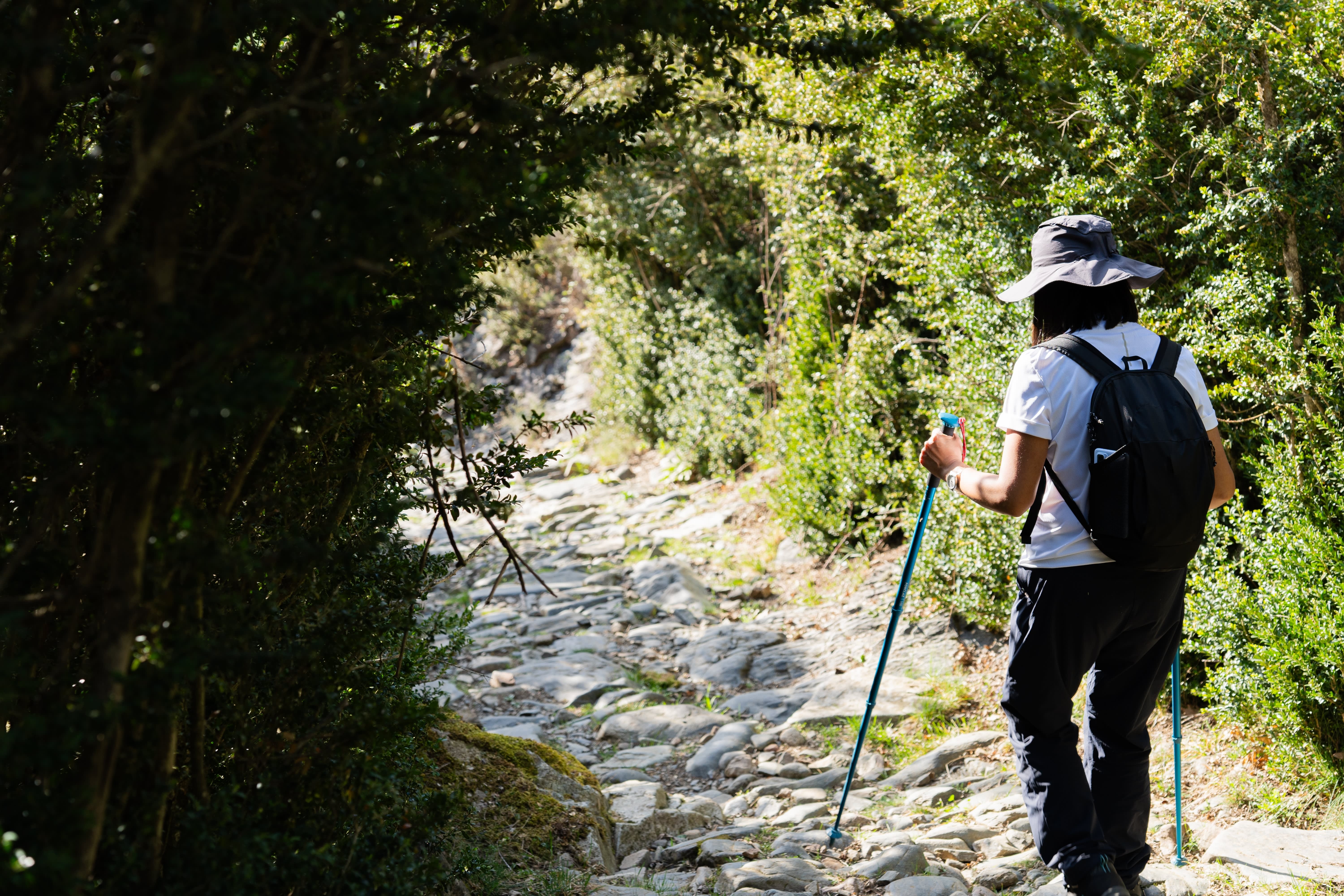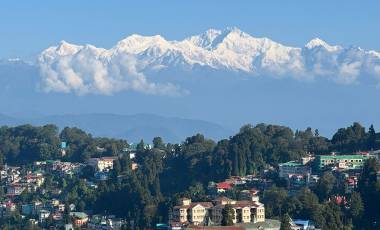Often referred to as the “Abode of the Gods” thanks to its spiritual roots and the sheer beauty of its towering snow-capped peaks, sweeping valleys and glaciers the Himalaya has attracted legendary hikers and travellers across the world for good reason.
The exhilarating physical challenge and rewarding sense of accomplishment when tackling the region’s famous rugged terrain and high-altitude trails are why many people head out on a trekking adventure in the Himalaya. However, there’s a lot to consider before you embark on the journey, which is something our veteran Exodus Leader, Valerie Parkinson, knows all too well. After 38 years of guiding in the Himalaya, Valerie is an expert when it comes to preparation and training; knowing how to acclimatise while trekking in high altitudes, and everything about what an adventure in the Himalaya actually entails. So, we got in touch with her, and she has shared with us the perfect Beginner’s guide to the Himalaya, which covers an introduction to the different regions, our trek gradings, key training tips, and suggested adventures that are ideal for beginners who want to start trekking in the Himalayan regions.

A short introduction to the Himalaya
Valerie explains, “Whether you’re new to trekking in altitude or an experienced trekker at elevated heights, the Himalaya has something for everyone, and it has some of the best mountain views on earth. She continues, “Many people have a dream of seeing the Himalaya but are deterred as they think they might struggle with the high altitude and inhospitable conditions of ice and snow. Some are worried they don’t have the stamina to continue trekking day in and day out – but nothing could be further from the truth. The Himalaya are much more than this. Spanning an impressive 2400km, the mountain range covers 5 different countries including, India, Nepal, Bhutan, Tibet and Pakistan. And each country offers incredibly diverse trekking conditions which means there is something for everyone and every ability level.”

“While Nepal is the most popular Himalayan destination for trekkers, it’s important to remember it’s not the only country in the Himalaya. Ladakh, in the Indian Himalaya is an area that is often overlooked, and yet, it has fantastic trekking on quiet trails and is a great choice if you have to take your annual leave in summer. Darjeeling and Sikkim is another interesting corner of northeastern India to explore and then there is Bhutan – the happiest country in the world, it’s almost mystical and well worth consideration.”
Understanding our trek grading levels
“Being clear on all your options certainly helps before committing to a particular trek”, Valerie says. So, to help you choose which trek in the Himalaya is right for you, we’ve created our walking and trekking grading system. The grade we give each of our treks is based on a variety of factors including the number of days walking, the altitude gain, the type of terrain, the remoteness, and the kind of accommodation we offer. We’d recommend that all of our customers, read the information in the trip notes online carefully and choose an appropriate graded trip based on your abilities. Valerie explains, “You might have a dream to make it to the Everest base camp or climb a 6000m peak, which is great. However, if you have never trekked before or been to altitude, it’s important to start at the beginning and work your way up towards your goal.”

How to Train
It’s essential for any trek to plan ahead of time and be realistic about how much training you might need, not only will this improve your physical fitness for the journey, but it will also boost your confidence in completing the trek itself. “One of the best ways to get fit for a trek is to walk regularly,” Valerie says. “Join local walking groups, where hills and rough ground are involved in the walks. Although there are decent trails in the Himalaya, there is rough ground, so decent balance is required.” She also recommends walking as much as possible in the boots and socks that you will be taking with you on the trip itself and using the same daypack too. If you are new to trekking poles, it’s important to practice using them as well.
“The gym is also a useful addition to add to your training. Use treadmills on an incline and wear your full daypack. Cross trainers are great for practising using arms and legs at the same time, as you will do on the trip with your trekking poles. Cardio and strength classes are good for building stamina. If you live or work somewhere that has flights of stairs this is great practice. Running is a fantastic way for getting fit, but you need to be confident on rough ground so make sure you include that as well. Remember, the fitter you are for a trek, the more you will enjoy it.” If you have any questions about the training process, our experienced staff in the Exodus office can be a great source of help and advice on where to start if you are still unsure.
Ideal Himalayan adventures for beginners
Valerie admits that choosing where to go trekking in the Himalaya is hard, but “it’s a good problem to have”. At Exodus, we have trails that suit varying levels of fitness, time requirements, interests, experience, and season. Here’s a snapshot of 3 Himalayan treks, chosen by Valerie that are perfect for beginners or seasoned hikers who are new to exploring the Himalayan region.

Annapurna to Chitwan: Walks & Wildlife
Walking time: 6 days | Highest Altitude: 2,012m | Grade 3
“Staying at low altitude, this itinerary is perfect for trekkers who are new to the Himalaya. The trip begins, by following a ridgeline along the lower Annapurna foothills, before descending into the Modi River Valley, where you’ll have stunning panoramas of Fishtail Mountain (Machhapuchhare). After passing rice fields, remote villages and farmlands you and your group will trek across suspension bridges and through sub-tropical forests to Dhampus. A momo-cooking experience in Tashiling, a dugout canoe ride along the Rapti River and a jeep safari across Chitwan National Park only adds to this incredible trekking experience – and you can expect to see spectacular views throughout. This trek is best done during the spring and autumn months.”
Find out more about our Annapurna to Chitwan: Walks & Wildlife here >>>

Darjeeling, Sikkim & the Singalila Ridge
Walking Time: 6 days | Highest Altitude: 3,636m | Grade: 4
“This trip combines a short trek with the culture of Darjeeling and Sikkim. The trek is grade 4 so ideal for those with some regular walking experience. There is one tougher day up onto the Singalila ridge, which straddles India and Nepal and has great views of Kanchenjunga. You will have 5 nights of full-service camping. This trek is best done in March, April and late October, November and December.”
Find out more about our Darjeeling, Sikkim & the Singalila Ridge here >>>

Bhutan: Druk Path Trek
Walking Time: 5 days | Highest Altitude: 4,235m | Grade: 4
“At the far eastern end of the Himalayan chain is Bhutan. Restricted to travellers for many years, this remote kingdom is culturally fascinating. The Druk Path is a 2-week trip with a short trek in the midst of all the highlights this amazing country has to offer. Due to Bhutan’s former cap on the number of annual visitors, the trails are much quieter, and you are unlikely to see other trekkers. The trekking days involve 4 nights of full-service camping, with mattresses and pillows included.
A trip to Bhutan is a once-in-a-lifetime experience, but it is generally more expensive than Nepal or India. Every visitor pays a Sustainable Development Fee as part of their trip, which goes directly toward supporting projects aimed at improving the facilities, services, and infrastructure for both the Bhutanese and visitors. Also, some of our departures to Bhutan aim to coincide with one of the major masked dance festivals in Bhutan – either at Paro or Thimpu, which is an incredible event to witness.”
Find out more about our Bhutan: Druk Path Trek here >>>
If Valerie’s Beginner’s Guide has inspired you to start planning a trekking trip in the Himalaya mountain range, view our incredible walking and trekking adventures in India, Nepal and Bhutan.






